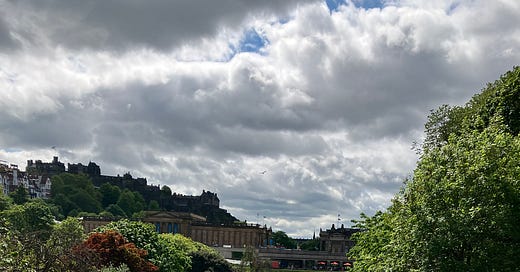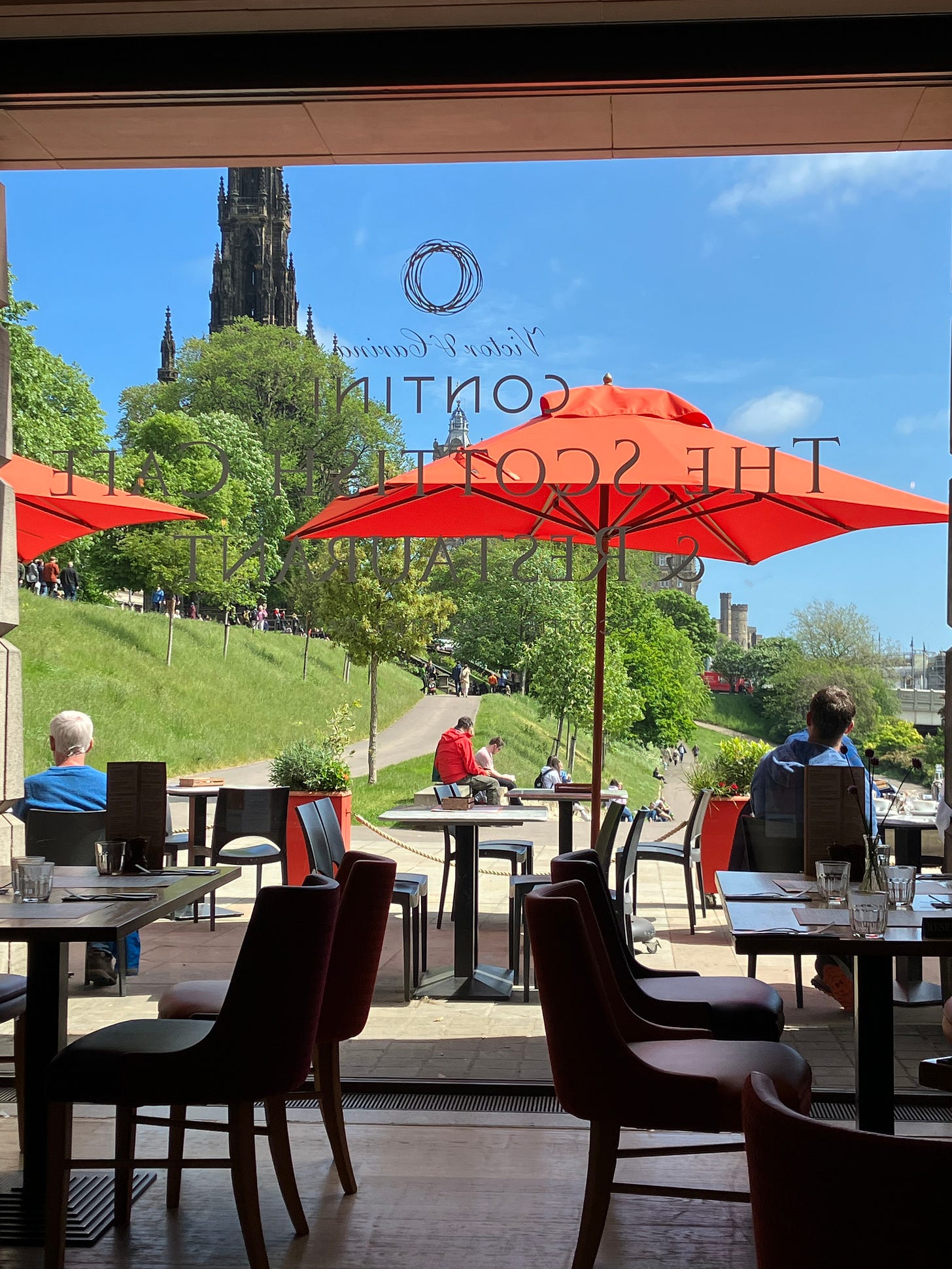This week we held a birthday party on Saturday for Elsie, our two-year-old granddaughter. Her cousins, twins Lilah and Freja, (17 months) were here, along with friend Millie (12 months) and ten adults. It was crazy, demanding, chaotic and joyous. The cake, despite some desperate last-minute repairs when one of the layers broke apart, was more than edible. It’s becoming a tradition. I make the cake, my own wholemeal sponge version in three layers, and my daughter Kate ices and decorates it. This year the theme–there is always a theme with Kate, and always beautifully executed–was woodland. There were bears in hats, pine cones, ferns, woodland flowers, you name it. The table looked glorious and very fitting for Chelsea week.
If you've been watching Chelsea, then more than likely, like me, you've fallen in love with Sarah Price's, Nurture Landscapes Garden. Judging by my instagram feed the whole world has fallen for it. Her garden recreates the essence of Benton End, former home of artist Sir Cedric Morris, famous for his flower painting and the bearded irises he cultivated. It is a painterly garden if ever there was one, a masterpiece of warm muted colours–pale pink, primrose, copper, apricot, lavender–semi-wild planting with a backdrop of pale terracotta, straw cob-walls and panels of painted canvas spread with climbing roses. It is a low carbon garden that repurposes and reuses materials old brick, ash, glass shells, feathers and wood. I am determined soon to use it as inspiration for some collage - I just need the spare time! I am also determined to get out into my own garden, which has definitely suffered from a lack of attention this year.
As always in Chelsea week, Monty Don–according to that reliable and reputable source The Sun, newspaper, known to admirers as Monty Ding Don! – was much on our screens. He impressed me this week, and not just for his raffish collection of linen scarves worn with elan, but for publicly agreeing that there was truth in the accusation that the Chelsea Flower Show is the preserve of the white, middle-aged, middle class from the Home Counties. How can you deny it with the ticket prices starting at £65.85 and a glass of champagne or was it Prosecco?–I think not, no second best at Chelsea– a cool £19.00. He defended the institution but said that there was still much more to do in making Chelsea a more welcoming and accessible space, encouraging diversity, and new, young designers and growers.
The same could be said of publishing, though there is a cult of youth and the debut novel in publishing and it’s more likely age that will be discriminated against. It feels like some of the imbalance is being redressed. Publishing is less white and less male. But as for class, well, a while back, an agent of mine told me that she thought my first novel, The Sweet Track (eventually published by Flambard Press) was too working class and that this was the main reason, despite her belief in it, that she was unable to sell it. I have no way of knowing if this was the truth, but I suspect it was part of the problem and that it still is. However, I'm not sure that the recent, 'working class writer,' movement, seen particularly on social media, does much other than ghettoise us. As for age, well the big publishers make noises about women over fifty, sixty even, but there is a failure to recognise the many older women now writing who missed the opportunity when younger or those who are avid lifetime readers. It is often left to the indie press to pick them up.
But getting back to Monty, there’s another reason he impressed me, and it was this: I came across a diary entry of his May 2003, The Ivington Diaries, reproduced here in Diaries of Note, where he conjures the beauty of May, evidenced now in startling greens and the soon-to-be-over profusion of May blossom. Is it my imagination or has it been at its most blossomy this year?
23rd May 2003
When I die I shall go to May. It will be green...the colour green in all its thousand shining faces...Every moment will be like the arc of a diver breaking the waters of a green lake. I know this because this is what May is like here and now. Almost unbearable really. It does not hold for half an hour. Yet in the shifting, growing hymn of light and colour and leaf is the still, simple reason that I garden.
I didn’t know that Monty was a writer as well as a gardener.
Writing brings me to my second major event of the week, which was to take myself and my cough that a sixty cigarette a day habit would be proud of, as well as my sudden explosion of floaters in my eye (necessitating an emergency eye exam. I wasn’t too worried. I'd hosted these strange black tiny fly like creatures that dance across my vision before, mainly a harmless event but it can signify a tear in the retina so you always have to have it checked out) to Edinburgh to meet my Linen Press editor Lynn Michell.
Edinburgh basked in the May sunshine. We made our way from Waverley Station along the the sloping lawns of East Prince’s Street Garden where the grass was scattered with folk on picnic rugs, their flasks and sandwiches at hand, to spend several wonderful, life-affirming hours, essentially a very prolonged lunch, but with only one glass of white, in the National Gallery cafe. We talked not only about plans for the publication of The Silent Women–about pre-order, about special offers, and launches, both my book and hers, The Water All Around Us, but also about up-and-coming Linen Press events. We discussed future plans, as well as our lives as writers and women of a certain age. We shared the good and the not quite so good of ageing. Like the party for Elsie, it was joyous but with none of the chaos. It was demanding though, in that there’s a lot still to be done, small details mostly. Novel writing does not finish with the writing of the book. If only! But Linen Press are aiming for a publication date in late July, with celebrations /events to follow early September.
You might think, it was a long way to go for lunch, even further for Lynn who had travelled to the mainland from the Western Isles, but it was worth every effort made. It reminded me, though I didn’t much need reminding, of the joys and benefits of being with a small press. There are disadvantages that cannot be denied, marketing budgets for one. You cannot expect your small press novel to sell in large numbers. Only independent book shops will stock it and then only by special arrangement. You are not likely to become a famous best selling author, something I might have hankered after long ago but which I think would bring demands I would actually hate.
Of course, as a writer you want your book to be read, and with a small press, the onus falls as much on you as on anyone, to become its champion and salesperson. For me the advantages far outweigh the disadvantages. The process is more intimate, and there are many more opportunities to influence how the book is produced, particularly for instance, what the cover might look like, which is one of the reasons I’m very excited about the re-jacketing of Sometimes a River Song. Cover reveal coming soon! As somebody who has studied the visual arts, I have strong views about the way things look. It’s almost unimaginable for me to be presented with a cover over which I have had no say or influence.
On the subject of things visual, if you didn’t catch the BBC Four programme, Close to Vermeer, on Tuesday evening, ‘a documentary following renowned Vermeer expert Gregor Weber, curator at the Rijksmuseum in Amsterdam, as he sets up the largest ever Vermeer exhibition,’ then you missed a treat. It was a jewel of a programme, befitting the small jewel-like canvases of the master himself. It transported me back to the early seventies and the days of my History of Art degree-course at East Anglia Uni. A course which ultimately, much later, was considered to be ground breaking in its observational approach. It was all about looking. Close examination and observation of the paintings, sculpture and buildings we studied was paramount. We were often forbidden to consult any text, any reference books. We wrote our essays from photographs alone. There was huge photographic library from which we borrowed. It was daunting at first. Terrifying! But it taught me to look with microscopic intensity. It taught me ways of looking too, a la John Berger, and I often think it was a great apprenticeship for a writer.
Thanks for reading
Avril x




'Monty Ding Dong' lol!I've always loved the man. And not as middle class as he appears. He did his A levels on an evening whilst working manual jobs. He was on the dole in the 90s after his business went bust, and suffers with depression. He's the right kind of eccentric for me. I love your novel, 'The Sweet Track'. It was the first time I connected a person I'd met with A1 work and thought, it is possible. I don't know what's so special about the middle class on a page? Mostly I find their world sanitised and tiresome. I'd write something including middle class characters, but what about the untidy spots, where the magic and music sings with the wallflowers along the yard walls. Without those poetic truffles we wouldn't have Chekhov.